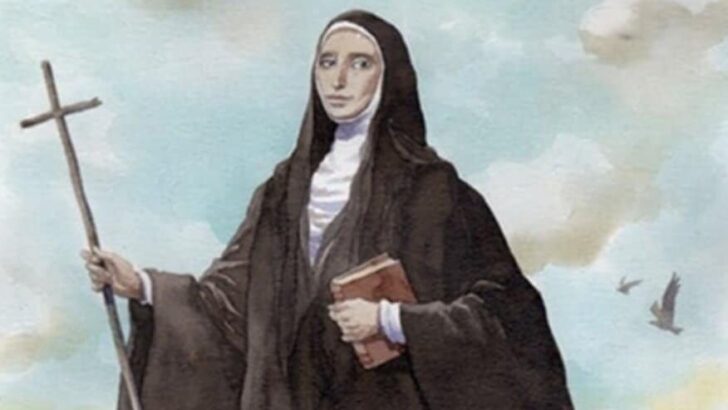By Severina Bartonitschek (KNA)
Argentinian summit meeting in the Vatican: one inspired people for the Christian faith over 200 years ago, the other has also been working towards this goal globally for eleven years, the third recently won an election with completely different convictions. 11 February could be an interesting date for the Pope’s home country. In St Peter’s Basilica, the former Archbishop of Buenos Aires will canonise “Mama Antula”, the first time a native Argentinian has been canonised. The new Argentinian President Javier Milei is travelling to Rome for the ceremony.
Although it is not unusual for a head of state to attend a canonisation, Milei’s reasons for making the journey are likely to go beyond the religious. Having been confronted with protests against his reform plans since taking office, he seeks to be close to the Pope. And his first trip home would at least be a respectable success for Milei.
This visit has been on the cards for some time, but has been on shaky ground since the libertarian politician’s election victory. Although the Pope has frequently expressed his desire to travel, he recently declared the realisation to be hypothetical. The preparations, which usually take months, have not yet begun.
The relationship between Milei and the head of the church is complicated to say the least. During the election campaign, the eventual winner sharply criticised the Pope and accused him of not distancing himself clearly enough from left-wing autocrats in Latin America. A few days before the presidential elections, Francis in turn spoke – without mentioning Milei by name – of “messianic clowns” who reminded him of the Pied Piper of Hamelin, who gathered people around them and then let them drown.
After the election, both sides moderated their behaviour – the Pope congratulated Milei on his election success by telephone and Milei officially invited Francis to Argentina. Milei will want to reaffirm the latter in Rome. However, Francis has already dampened expectations. Before canonisations, it is customary to greet the authorities in the sacristy. He is aware that Milei has asked for a meeting beyond this. It is planned for 12 February. Francis has said that he is ready for a dialogue – just like with anyone else. That doesn’t sound very euphoric. The reason for the meeting, the canonisation, is all the more interesting.
While Francis and Milei have little in common, the future saint shares the same spirituality as the Jesuit Pope. Born Maria Antonia de Paz y Figueroa in north-west Argentina in 1730, she made contact with the local Society of Jesus at a young age. The daughter of a respected family, she was particularly fascinated by the Ignatian Spiritual Exercises. The spiritual exercises according to Ignatius of Loyola were intended to lead to a dialogue with God and open up a path for people to follow Christ through prayer.
From then on, the young Argentinian wanted to lead a religious life. At the age of 15, she took a vow similar to that of a religious order – she wanted to live chastely and poorly – and joined a loose community of women in the neighbourhood of the Jesuits. However, her closeness to the men of the order was short-lived. The ban and expulsion of the Jesuits for political reasons also affected the men of the order in the Spanish colony of Argentina.
After 1767, Maria Antonia took over the spread of Ignatian spirituality, travelling from town to town as the itinerant missionary “Mama Antula” as far as Uruguay. According to a chronicle, her appearance was met with incomprehension at the time – confused, drunk, she is said to have been labelled a witch by both civil and ecclesiastical authorities. Nevertheless, she reached people. It is said to have reached 70,000 within a few years, including many indigenous people and slaves. She founded a retreat centre in Montevideo and later one in Buenos Aires. She died there in 1799 at the age of 69 and is buried in the Basilica of Nuestra Senora de la Piedad. Retreats are still offered in the “Santa Casa” today.
Maria Antonia was beatified in 2016 and thus released for regional veneration. The prerequisite for this is a virtuous lifestyle in combination with a miracle. At that time, it was the healing of a nun through her intercession. The second miracle required for canonisation was the healing of a man who suffered brain damage after a stroke. The doctors were unable to find a logical explanation for his recovery. So after her canonisation on 11 February, Mama Antula can be venerated worldwide – including by her compatriot Francis, with or without a visit home.


 This is a painting of Blessed María Antonia de San José, an 18th-century consecrated laywoman from Argentina who will be canonized in early 2024, according to an Oct. 24, 2023, announcement by the Vatican. A miracle through her intervention that was needed for her canonization was recently authenticated. San José, popularly known as "Mama Antula," will be Argentina's first home-grown female saint (OSV News artwork/Enrique Breccia)
This is a painting of Blessed María Antonia de San José, an 18th-century consecrated laywoman from Argentina who will be canonized in early 2024, according to an Oct. 24, 2023, announcement by the Vatican. A miracle through her intervention that was needed for her canonization was recently authenticated. San José, popularly known as "Mama Antula," will be Argentina's first home-grown female saint (OSV News artwork/Enrique Breccia) 